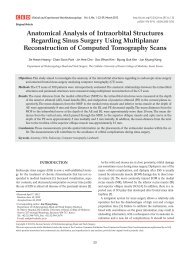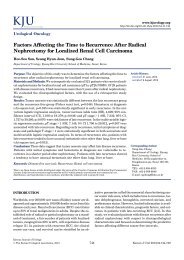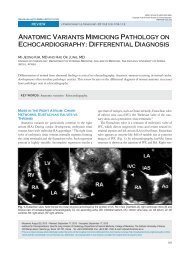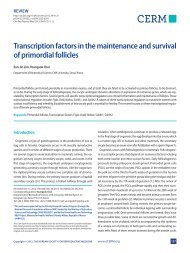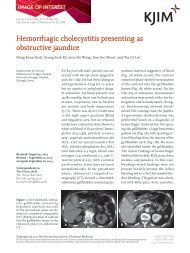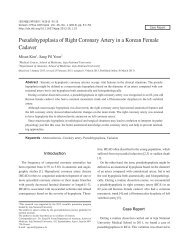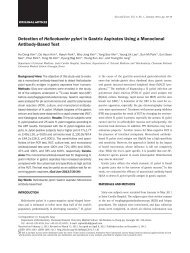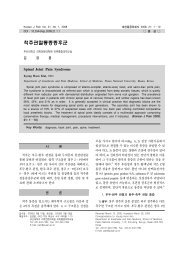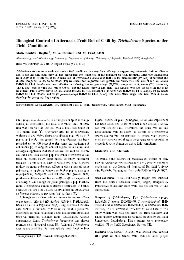Lateral Calcaneal Artery Adipofascial Flap for Reconstruction of the ...
Lateral Calcaneal Artery Adipofascial Flap for Reconstruction of the ...
Lateral Calcaneal Artery Adipofascial Flap for Reconstruction of the ...
Create successful ePaper yourself
Turn your PDF publications into a flip-book with our unique Google optimized e-Paper software.
s<strong>of</strong>t-tissue defects were caused by acute trauma in three<br />
patients and a chronic ulcer in two. The flaps ranged in<br />
size from 3.5 × 2.5 cm to 5.5 × 4.0 cm. The patients’ ages<br />
ranged from 4 to 72 years (mean, 37.2 years), and <strong>the</strong><br />
follow-up period ranged from 6 to 18 months (mean, 11<br />
months).<br />
Operative Procedure<br />
Be<strong>for</strong>e surgery, <strong>the</strong> peroneal and lateral calcaneal artery<br />
presence and patency were confirmed. The tissue used <strong>for</strong><br />
<strong>the</strong> adip<strong>of</strong>ascial flaps was in <strong>the</strong> same areas as <strong>the</strong> lateral<br />
calcaneal artery skin flap. 2) The flap sizes required to cover<br />
<strong>the</strong> heel defects were marked on <strong>the</strong> skin. Initially, a zigzag<br />
skin incision was marked in <strong>the</strong> central portion <strong>of</strong><br />
<strong>the</strong> proposed flap. Surgery was aided with a tourniquet<br />
and surgical loupes (× 2.5). The incision was deepened<br />
through <strong>the</strong> skin down to <strong>the</strong> subcutaneous tissue and<br />
superficial venous plexus. The overlying skin was dissected<br />
at this venous plane and <strong>the</strong> lesser saphenous vein and<br />
its contributors were identified and preserved on <strong>the</strong> flap<br />
surface <strong>of</strong> <strong>the</strong> flap.<br />
After <strong>the</strong> skin over <strong>the</strong> proposed flap had been<br />
dissected completely, <strong>the</strong> initial incision <strong>for</strong> elevation<br />
<strong>of</strong> <strong>the</strong> fascial side <strong>of</strong> <strong>the</strong> flap was made at <strong>the</strong> posterior<br />
aspect <strong>of</strong> <strong>the</strong> lateral malleolus and extended proximally<br />
along <strong>the</strong> fibula and lateral tendon <strong>of</strong> <strong>the</strong> peroneus<br />
longus muscle. Through traction and elevation <strong>of</strong> <strong>the</strong><br />
medial edge <strong>of</strong> <strong>the</strong> adip<strong>of</strong>ascial flap, <strong>the</strong> lateral calcaneal<br />
vessels and accompanying sural nerve were identified<br />
in <strong>the</strong> suprafascial layer. This neurovascular pedicle was<br />
protected and kept in <strong>the</strong> flap, and used as an anatomical<br />
landmark <strong>of</strong> <strong>the</strong> proper plane to undermine <strong>the</strong> fascia.<br />
The sural nerve was dissected by incising <strong>the</strong> fascia<br />
and preserved. However, its branches to <strong>the</strong> flap were<br />
separated interfascicularly and retained in <strong>the</strong> flap. The<br />
posterior edge <strong>of</strong> <strong>the</strong> flap was incised close to <strong>the</strong> Achilles<br />
tendon near <strong>the</strong> calcaneus and carried down to <strong>the</strong><br />
periosteum. Undermining <strong>of</strong> <strong>the</strong> fascial side <strong>of</strong> <strong>the</strong> flap<br />
was straight<strong>for</strong>ward when <strong>the</strong> dissection was per<strong>for</strong>med<br />
Table 1. Clinical Data <strong>of</strong> <strong>the</strong> Patients<br />
3<br />
Chung et al. <strong>Lateral</strong> <strong>Calcaneal</strong> <strong>Artery</strong> <strong>Adip<strong>of</strong>ascial</strong> <strong>Flap</strong><br />
Clinics in Orthopedic Surgery • Vol. 1, No. 1, 2009 • www.ecios.org<br />
immediately over <strong>the</strong> periosteum <strong>of</strong> <strong>the</strong> calcaneus and <strong>the</strong><br />
dissection could be accomplished through this site. 8)<br />
The pivot point <strong>of</strong> <strong>the</strong> flap lies proximal to <strong>the</strong><br />
superior edge <strong>of</strong> <strong>the</strong> calcaneus where <strong>the</strong> lateral calcaneal<br />
artery emerges. The proximal base <strong>of</strong> <strong>the</strong> flap was not<br />
narrowed and included <strong>the</strong> lateral calcaneal vessels, <strong>the</strong><br />
superficial venous system and fascicular branches <strong>of</strong> <strong>the</strong><br />
sural nerve. 8)<br />
After rotating <strong>the</strong> flap to <strong>the</strong> recipient area, <strong>the</strong> donor<br />
site was closed primarily with preserved skin, and<br />
multiple small silastic drains or a suction drain was inserted.<br />
A moist, loose 1% framycetin sulfate-impregnated<br />
sterile tulle gauze dressing with a wet dressing was simply<br />
placed over this flap until <strong>the</strong> skin graft was per<strong>for</strong>med.<br />
On postoperative days 5 to 7, <strong>the</strong> raw surface <strong>of</strong> <strong>the</strong> flap<br />
on <strong>the</strong> recipient site was covered with a full- thickness skin<br />
graft (Fig. 1).<br />
RESULTS<br />
Table 1 shows <strong>the</strong> patient data. All five flaps had good<br />
perfusion and survived completely. No venous congestion<br />
was noted but flap edema lasted <strong>for</strong> 3 days. The skin grafts<br />
on <strong>the</strong> adip<strong>of</strong>ascial flap had taken well in 4 patients. One<br />
case (case 3) suffered partial loss <strong>of</strong> <strong>the</strong> full-thickness skin<br />
graft on <strong>the</strong> flap that was associated with a thin hematoma<br />
beneath <strong>the</strong> skin graft. However, this healed spontaneously<br />
without <strong>the</strong> need <strong>for</strong> a secondary graft. In all patients, <strong>the</strong><br />
donor sites <strong>of</strong> <strong>the</strong> adip<strong>of</strong>ascial flap were closed primarily<br />
without any functional impairment and healed. One case<br />
(case 4) was complicated by a hematoma at <strong>the</strong> donor<br />
site, which was emptied by suction and compression.<br />
Marginal desquamation <strong>of</strong> <strong>the</strong> donor site wound occurred<br />
in one case (case 2) but it subsequently healed. All patients<br />
became ambulatory after wound healing, and ankle<br />
motion was not restricted. There was no subsequent<br />
breakdown <strong>of</strong> <strong>the</strong> grafted skin with <strong>the</strong> regular wearing <strong>of</strong><br />
shoes.<br />
Case Age (yr), Sex Cause <strong>of</strong> defect Site <strong>of</strong> defect Size <strong>of</strong> flap (cm) Duration <strong>of</strong> follow-up (mon) Complication<br />
1 4, F Acute trauma Posterior heel 4.5 × 3.0 18 None<br />
2 38, M Acute trauma Posterior heel 5.5 × 4.0 11 Marginal desquamation <strong>of</strong> <strong>the</strong> donor site<br />
3 65, F Chronic ulcer Posterior heel 5.5 × 3.5 14 Partial loss <strong>of</strong> <strong>the</strong> full-thickness skin graft<br />
4 7, M Acute trauma Posterior heel 3.5 × 2.5 8 Hematoma <strong>of</strong> <strong>the</strong> donor site<br />
5 72, M Chronic ulcer Posterior heel 5.0 × 4.0 6 None



